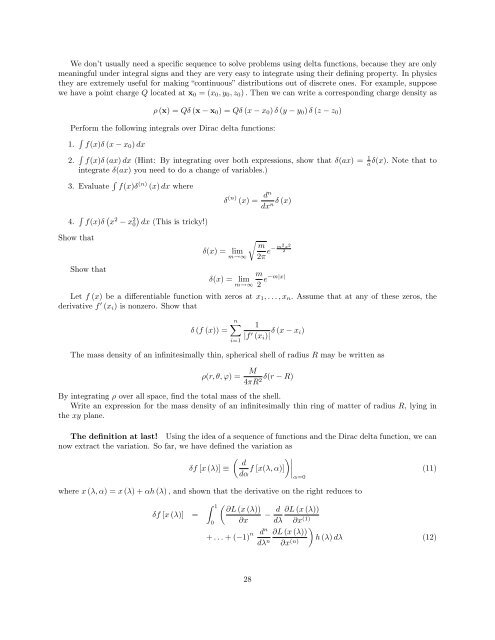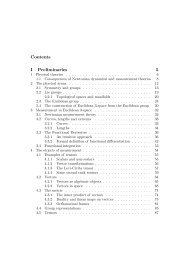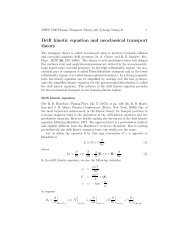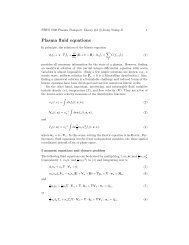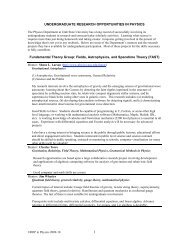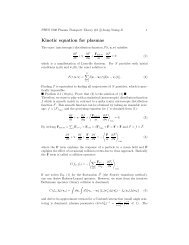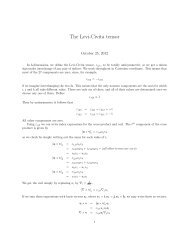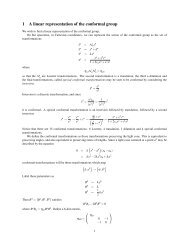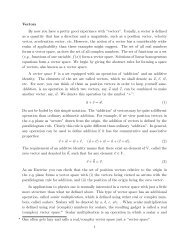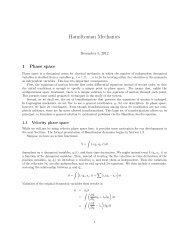Wheeler, Mechanics
Wheeler, Mechanics
Wheeler, Mechanics
Create successful ePaper yourself
Turn your PDF publications into a flip-book with our unique Google optimized e-Paper software.
We don’t usually need a specific sequence to solve problems using delta functions, because they are only<br />
meaningful under integral signs and they are very easy to integrate using their defining property. In physics<br />
they are extremely useful for making “continuous” distributions out of discrete ones. For example, suppose<br />
we have a point charge Q located at x 0 = (x 0 , y 0 , z 0 ) . Then we can write a corresponding charge density as<br />
ρ (x) = Qδ (x − x 0 ) = Qδ (x − x 0 ) δ (y − y 0 ) δ (z − z 0 )<br />
Perform the following integrals over Dirac delta functions:<br />
1. ∫ f(x)δ (x − x 0 ) dx<br />
2. ∫ f(x)δ (ax) dx (Hint: By integrating over both expressions, show that δ(ax) = 1 aδ(x). Note that to<br />
integrate δ(ax) you need to do a change of variables.)<br />
3. Evaluate ∫ f(x)δ (n) (x) dx where<br />
δ (n) (x) = dn<br />
dx n δ (x)<br />
4. ∫ f(x)δ ( x 2 − x 2 0)<br />
dx (This is tricky!)<br />
Show that<br />
Show that<br />
√ m<br />
δ(x) = lim<br />
m→∞ 2π e− m2 x 2<br />
2<br />
m<br />
δ(x) = lim<br />
m→∞ 2 e−m|x|<br />
Let f (x) be a differentiable function with zeros at x 1 , . . . , x n . Assume that at any of these zeros, the<br />
derivative f ′ (x i ) is nonzero. Show that<br />
δ (f (x)) =<br />
n∑<br />
i=1<br />
1<br />
|f ′ (x i )| δ (x − x i)<br />
The mass density of an infinitesimally thin, spherical shell of radius R may be written as<br />
ρ(r, θ, ϕ) =<br />
M δ(r − R)<br />
4πR2 By integrating ρ over all space, find the total mass of the shell.<br />
Write an expression for the mass density of an infinitesimally thin ring of matter of radius R, lying in<br />
the xy plane.<br />
The definition at last! Using the idea of a sequence of functions and the Dirac delta function, we can<br />
now extract the variation. So far, we have defined the variation as<br />
( )∣ d<br />
∣∣∣α=0<br />
δf [x (λ)] ≡<br />
dα f [x(λ, α)] (11)<br />
where x (λ, α) = x (λ) + αh (λ) , and shown that the derivative on the right reduces to<br />
δf [x (λ)] =<br />
∫ 1<br />
( ∂L (x (λ))<br />
− d ∂L (x (λ))<br />
0 ∂x dλ ∂x (1)<br />
+ . . . + (−1) n d n<br />
)<br />
∂L (x (λ))<br />
dλ n h (λ) dλ (12)<br />
∂x (n)<br />
28


